I had my one week check in with the eye doctor today. He says my eyes have healed up and I can wear my contacts again. Woot! I'll be able to see on vacation next week!
There's a new kind of contact for my condition from SynergEyes for my problem. There is a big waiting list to get the diagnostic kite (whatever that is) so that I can be fitted. Not one to wait patiently, I called up Synergeyes and simply asked for them to send the kit to my doctor. They were helpful and are going to call him directly and see what can be done to speed things up.
Who knows if it will help, but if you don't ask, you never know.
I knew this day would come sometime. After wearing my contacts for 18+ hours a day, everyday, my eyes have finally rebelled and decided not to cooperate any more.
Bright light had been causing me pain and I finally went to the eye doctor yesterday. My eyes have been injured a bit a nd need time to heal. What that means is no contacts for a week or until everything is healed up.
Due to my condition, keratoconus, this is a big deal. The condition does more than just make me nearsighted, it creates a smearing of what I see. Kinda like permanent double vision.
Special contacts basically give me 20/20 vision by correcting for the myopia and the optical bending that causes the smears. Most people wouldn't know that I'm legally blind without my contacts. Without my contacts, I need to hold things about six inches from my face to have any chance to read it. Even then, I need to squint to see anything. I do have glasses, but they can't correct for the smearing or fully for the near-sightedness. As a result, the glasses extend my reading range out another foot or so.
To write this on the computer, I need to lean far forward and increase the font size on the computer pretty high. Spending more than 45 minutes or so trying to read or use the computer guarantees a headache and sore eyes from squinting.
While this sucks and all, I have it good compared to some people and their eye problems. There are many people that never get a chance to see well at all. In that respect, I feel very lucky that I get to see normally most of the time. Of all the maladies that people suffer, I got off easy compared to many.
So what does it mean? It means I can't drive or really work. Work involves a lot of reading and computer work. I can't watch TV, it's all a blur, even with my glasses on. So while my eyes heal, I basically need to walk around with my glasses off and do nothing.
Too top it all off, the dog chewed off the end of my glasses where they rest on your eyes, so I need to go out and get new frames for the lenses.
So I will see you all in a bit. Until then, do good work.
Tonight I will be speaking to SMPTE Hollywood about digital media stuff. They spelled my name wrong, but here's the panel I'll be on.
Specifically I'll be talking about "practical issues involved with creating portable media from traditional digital media workflows - transcoding content to the right format as well as metadata, XML conversion, DRM, storage and network/transport". Thrilling stuff folks!
If you a television turbo-geek, please come heckle.
Warning: The SMPTE web site has a very 1999 design feel to it, so any creative types or designers should be wary, lest your eyes bleed. I'm not kidding, it would toss Jason Kottke and Khoi Vin into a epileptic fits if they ever saw the site.
After our nice find of Java Juice as instant coffee, Michele was on the look out for other options. While shopping at the 99 Ranch Market (an Asian supermarket in LA), she found a box of Casa Coffee.
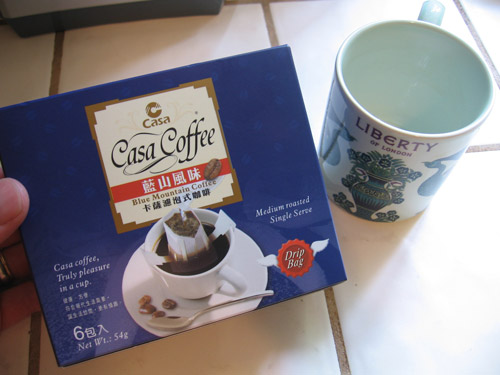
Sure enough it's another way brew a single cup of coffee for those of us that are coffee machine challenged.
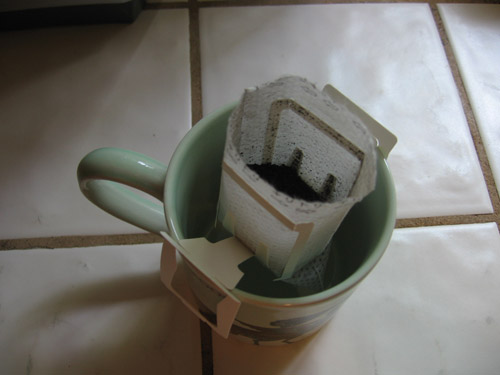
Basically, it's a single use drip coffee packet. You rip off the top and place it in the cup. The Casa Coffee people call it a 'flying bag' due to the wings on the outside that hold the coffee packet in place.
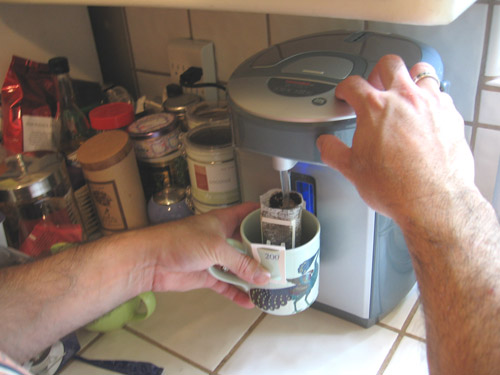
Pouring the water in was a bit troublesome. It didn't work so well trying to use the hot water dispenser. I assume they intend you to use a teapot.
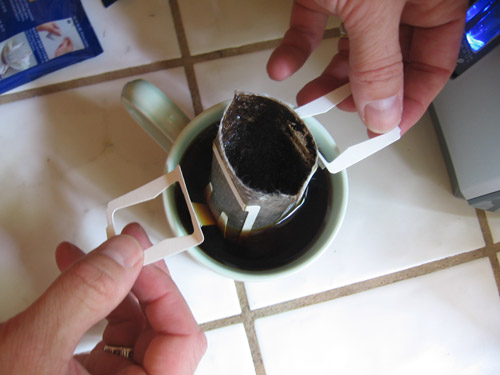
Once the water was in the coffee got one pass though the grounds and into the cup. In theory, it works just like a standard drip coffee maker.
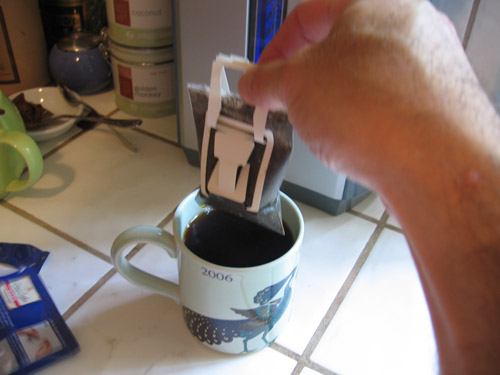
Once the water it through, you lift the 'wings' and toss the used coffee packet away.
Too bad the coffee didn't taste too good. Maybe they didn't use good beans to start, or maybe I didn't let it steep right, but the coffee was weak and tasted a bit stale. The mouth feel was wrong, missing that essential oil that just barely is seen on fresh brewed coffee. It would do in a pinch, but I prefer even the powdered instant more.
I gave it a second try the next day. I poured the water in a bit too fast and the grounds overflowed the filter and went into my cup. I spent the next five minutes trying to get the floating grounds out of the cup. Falling at that, I put in extra sugar and drank it down anyways.
I have to give props to Casa Coffee for a neat idea,but they probably need a one way filter system that prevents overflow and better beans. By the way, be sure to check out the impressive Casa Coffee wallpaper!
Last weekend, the hard drive in our media server died. This sucks, but is not the end of the world, we had backups. This is the second time the hard drive in the media server has died. My best guess is that this is due to excessive heat.
To prevent further losses, I've replaced the hard drive with a pair of hard drives in a RAID set. A RAID is basically telling two hard drives to act as one. If one fails, you have the other. I also bought an external hard drive to do even more backups.
But I need to address the heat issues. Michele is insistent that the covers stay on the computer. So, the easy method, leaving the sides off, is right out.
That meant using forced air blown through the case. I had a ultra-quiet Cooler Master fan and a grill for another project I never got around to doing.
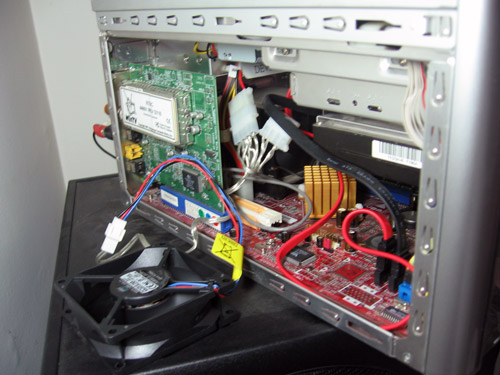
So I had to figure out to mount this fan on the inside of the case. It had to mount on one of the side panels with a grill on the outside to protect from the fan and cover the cut-out.
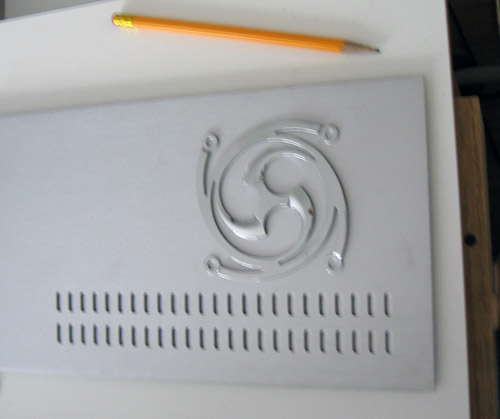
After getting a good idea where the fan would fit, I laid the grill on the outside to make sure I could mark the drill and cut-out lines well.
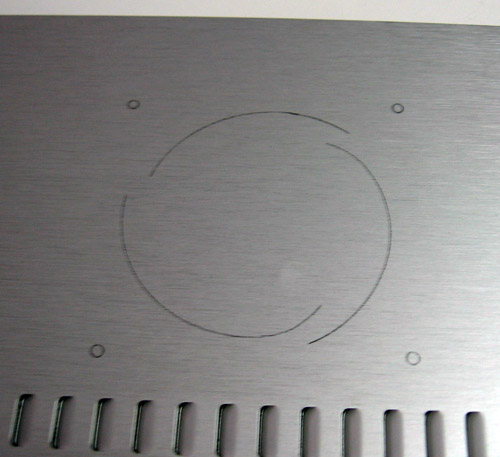
I drew the lines and checked them 3 times. My father always says, "Measure twice, cut once." and he's right. If I messed up the outer case, it not like I can run to the hardware store for another one.
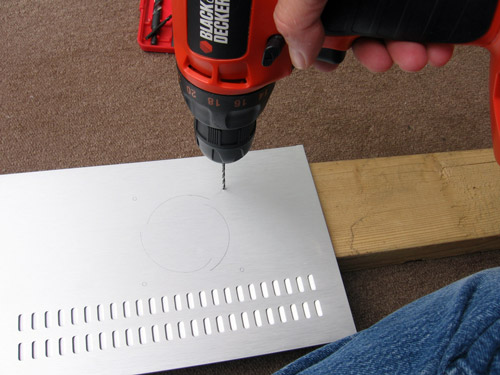
Next I drilled the screw holes. That allowed me to keep checking on the cut-out as they are the point of reference. Note the scrap lumber underneath to get a clean hole as I drill through.
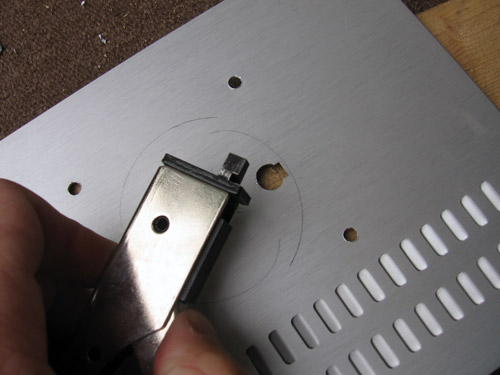
Now a pilot hole for the nibbler was drilled near the where I needed the edge of the cut-out.
What's a nibbler you ask? Well, it's a special tool for cutting out bits of metal. Bascially takes little bites out of metal. Mine is tiny and only takes about 1/8" by 1/4" bites out of aluminum or thin steel. Good for precision work.
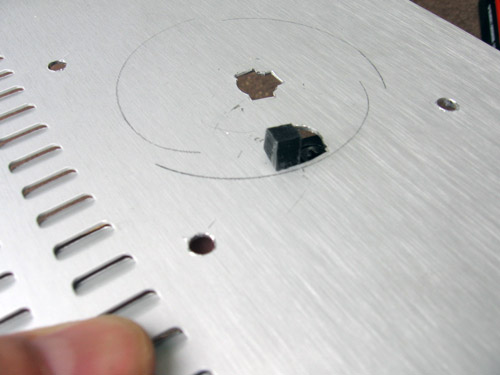
Once the hole there, I can place the nibbler inside it and start. You can see how I can track the line to nibble by just watching the top follow the cut line.
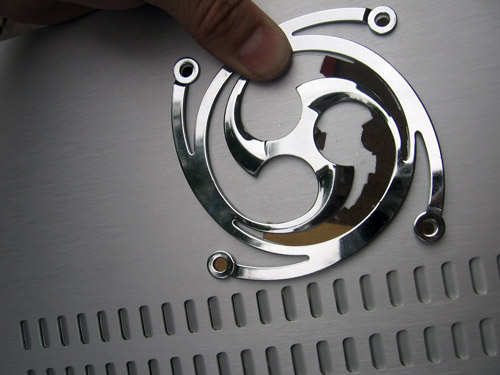
Again, be very careful not to make a mistake, I repeatedly compared the grill to the hole I was cutting out.
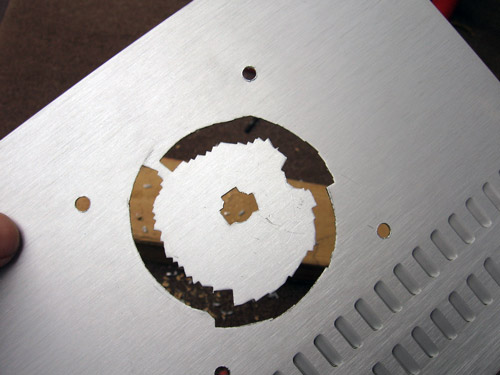
This is the hole only a few nibbles before completion. You can see a few of the cut-out bits on the ground. You need to be sure to vacuum these up. They are sharp and can cut feet easily, whether they human or canine.
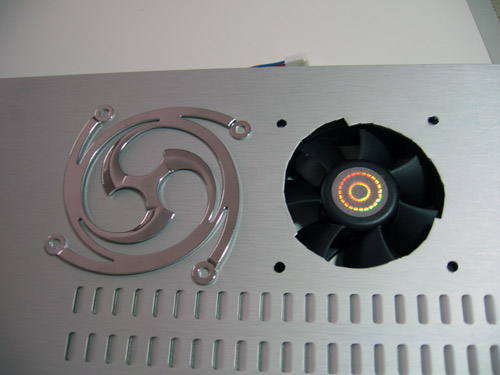
Here is the fan in place, behind the side panel with the grill ready to get screwed together.
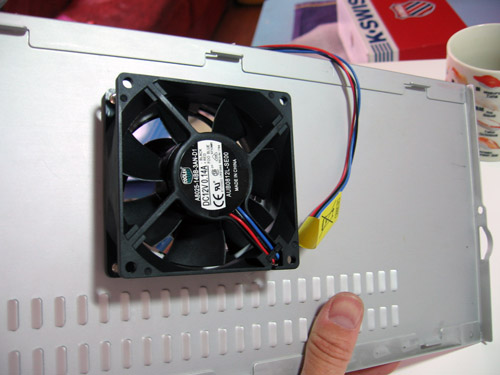
Once in place, the fan is ready to go.
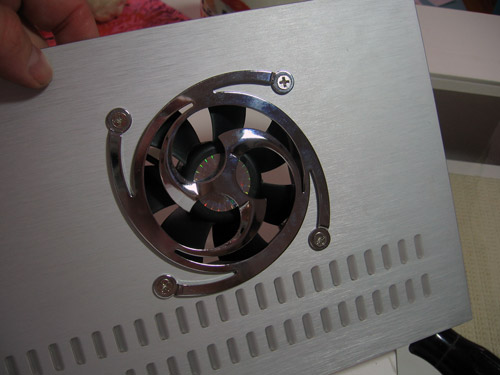
Here is the grill in place as well. Looks pretty good, eh?
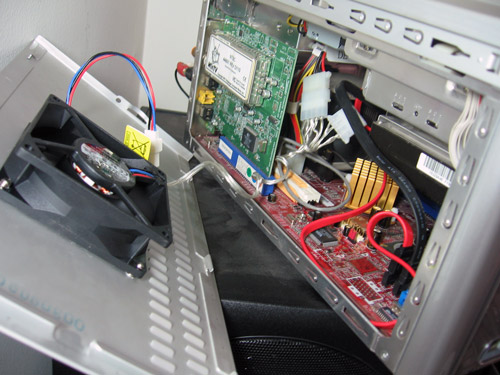
The power is plugged into the fan, and I'm ready to close up the case.
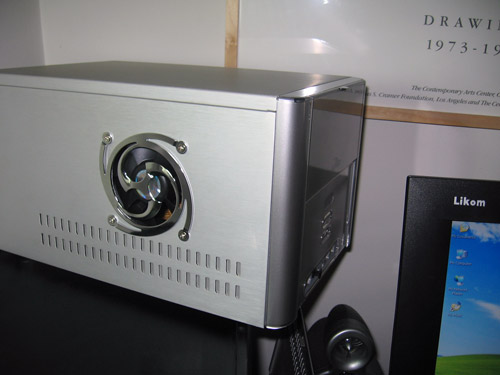
Last step was checking for Michele's approval. She thought it looked nice as well.
Project complete.
If you want to try it yourself, it's fairly simple. The keys are having the right stuff (fan, grill, and a nibbler) and taking your time. Rushing the nibbling or trying to use a makeshift tool like a file instead will to disaster.
Perhaps it was a good thing I was not an adult in the 70s. Listen to that applause...
In the last week, I've gotten a half dozen emails about advertising on Cruftbox and three different headhunters called me to offer jobs.
Wha? I am simply not that in demand. My unhealthy fascination with junk food alone should scare most people away.
What happened? Did someone post me on a milk carton or a bathroom wall?
create your own visited states map or check out these Google Hacks.
Over at Vox where Anil and the cool people are partying, I saw this interesting graphic tool about states you've visited. I guess driving around the US a few times makes a difference.
Update:
I received this from my father:
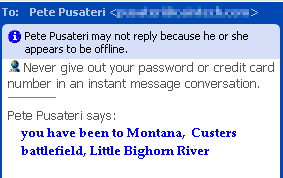
So, sure enough, I've been to Montana.
I've actually been reading a lot lately but have been neglecting my reviewing duties. Friends and family know that I've read this book, because I can't stop talking about it.
The Omnivore's Dilemma - Michael Pollan
Michael Pollan is a writer for the New York Times. I heard him speak on the radio about our food and how it is made. It was intriguing and I picked up the book for our trip to Hawaii.
Basically, Pollan looks at how food gets to the supermarkets where the vast majority of Americans shop. The reality he explains is astounding. Now, before you think I'm just some hippy on the net hyping the latest granola-eating idea that comes down the pipe, let me describe my food habits. We buy the majority of our food at Pavilions and Ralph's supermarkets, with the occasional trip to Trader Joe's for unique items. We eat fast food a couple times a week as a family and I personally eat out every day at lunch. We do buy organic eggs and milk and when the opportunity arises 'free range' and organic meat.
In his examination of the corn industry, I was amazed at the absolute insanity of the system of corn farming. Due to the government's intervention on behalf of the large food processors (like ADM), the price of corn is less than the cost to grow it and the corn industry has become dependent on oil-based fertilizer (surprise!). The amount of corn produced is huge and the food processors invented high fructose corn syrup in the early 80s to find a use for all the corn produced. Today, with corn syrup in pretty much everything we eat, the new corn product being pushed is... ethanol (surprise!).
Next he looks at what the label 'organic' really means. Again, I found this fascinating. In short, organic just means that a farmer doesn't use pesticide or fertilizer on plants and doesn't use hormones or anti-biotics on animals. The majority of 'organic' food is still grown by mega-agribusiness in huge amounts. Thinking now about people that shop at places like Whole Foods get their food as opposed to the 'regular' supermarket is a bit funny. Organically labled food is the same whether you buy it at Safeway or Whole Foods. The silliness of it even gets bigger when you start thinking about buying organic out of season fruits that rode in exhaust spewing aircraft to get from South America to the US in the name of being 'healthier'.
I do have to say that buy buying organic, you are getting a product that doesn't have pesticides or fertilizers in them. That is a good thing, but organic foods are not the panacea to America's food problems.
Polland describes the Polyface farm as an example of a sustainable farming method that by all accounts is the best way you could hope to get your food. I have to admit I was enamored when reading it, but some of the concepts don't scale to amount of food needed to feed cities of hungry people. If I lived near Polyface Farm in Virgina, I'd go out of my way to buy their food. Pollan leads from hear into a brief desciption of the 'slow food' and 'eat local' movements. Both movements argue that eating food that is produced near to where you live is better in almost every way than eating food that is produced far away and shipped to you.
The point Polland makes about food labeling is superb. When was the last time you went to the store and saw the name of the farm where your oranges were grown? Was it in Florida or California? If you had questions about the farm where your 'free range' chicken was raised, who coudl you ask? Big agribusiness does not want you asking or thinking these kinds of questions. They want you to think that all eggs and oranges and apples and milk is exactly the same. You know this isn't true.
Why do you think the good chefs are picky about the food they cook with? It's because the little things matter in food. Honey made by bees that live near Clover is much different than the honey made by bees near tupelo. Beef from cows that eat grass is different than that from 'corn fed' cows.
After reading the book, I went to our local farmer's market with the kids. Sure enough, the people there could tell you exactly where the food came from, most of it local. But the selection just isn't there. Eating local means no corn in winter and no grapes in the spring. I liked the ideas, but it takes real effort to eat local and sustainably. It's more than driving to Whole Foods.
The last part of the book deals with hunting and gathering. This part was interesting, but not particularly revealing. Those that have qualms about eating meat yet do may find it deeper, but I came to grips with being carnivorous ethically long ago. Each person needs to make up their mind about eating meat. Either eat meat or go vegan I don't care, but I do care if you haven't given the matter some thought.
If you can't tell already, I highly recommend the book to anyone that has a passing interest in what they eat. If you haven't done much reading about food before, you won't be disappointed.
Pollan has a good weblog about these idea at the New York Times, but it's behind the pay wall where most people can't read it. We read the printed on paper Times, so we get to read it. It's a shame that the Times can't find sponors to make the column free to read.
Last weekend, we helped our friends with their garage sale. They advertised and set up the sale. We brought over our crap, err, our fine pre-owned items and helped out with the sale and watching the kids.
In the middle of everything was this fantastic item.
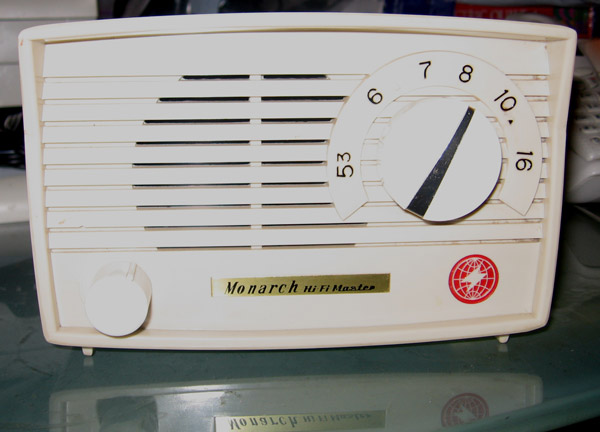
What's so special about this radio? Looks like a simple AM radio to most, but this ia actually a tube radio.

Sure enough, this is a 5 vacuum tube model AM radio from the early 60s. An explanation is in order. Back in the early days of electronics, vacuum tubes we the key to all modern innovations from radio and TV to amplification of signals.
Like the sound of electric guitars and the speed of microwave ovens? Thank vacuum tubes.
People in their 30s and older will likely remember TV commercial that told you to when your TV broke, you could bring the tubes from your TV for easy replacement. They had special kiosks at the supermarkets for the testing of the tubes.
Vacuum tubes have mainly been replaced by transistors in almost all uses. A few niche markets remain, like broadcasting and audio enthusiasts, but by in large it's a forgotten technology. The 'tube sound' or 'tube amp' refers to the use of vacuum tubes in audio systems. Some people swear by the tube sound, but I can't hear much of a difference between it and a good solid state (transistor) amplifier.
I had a brief education in tubes (or valves as the rest of the world calls them) in college in the late eighties. But they still fascinate me. There's a brisk market on ebay for tube radios, but they aren't worth a lot.
This radio was from the last generation of vacuum tube based radios that were meant to compete with the new transistor based radio arriving on the scene. Transistor radios were smaller and ran off of battery power, unlike the larger tube radios than needed to plug into the wall.
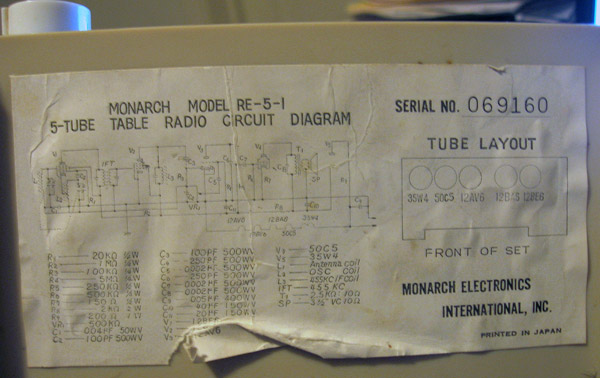
The radio works great. I adjusted the dial, listened to a baseball game on it, and was in heaven.
Best of course is that the schematic diagram and tube callout is on the bottom, ensuring that I can keep this running forever.
For a while now, I've been drinking instant coffee at home. Michele put our coffee maker up in a cupboard and replaced with a hot water dispenser. It's great for tea, but it leads to instant if you want coffee. I've tried various Japanese instants and those found in the regular supermarket from Folgers and Maxwell. They are OK, but nothing great.
When I was in Europe I found these small coffee packets that held instant coffee for one cup. I really enjoyed them and had horded a few that I brought home. When I started searching on the net for how to get them in the US, I bumped into Java Juice. I started reading the site and was intrigued. I bought some and awaited it's arrival to Cruft Manor.
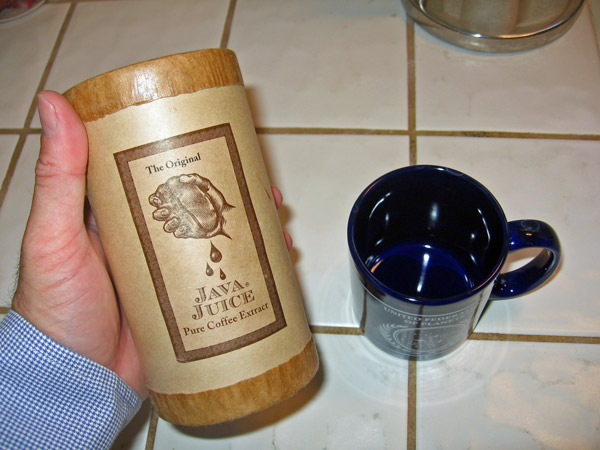
I opened the box and was pleased with the package. Quite a departure from standard supermarket style, the canister had a good tactile feel and appears to be useful for other things once the coffee is gone.
The coffee is made from organic beans and is even kosher. They even mention that the benas are 'fair trade'.
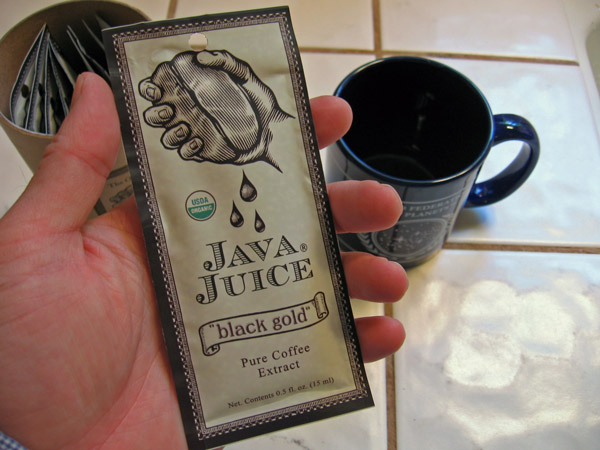
The coffee extract comes in a packet. It's not powdered instant coffee, it's a liquid. The idea is that it is easily mixed into anything.
Java Juice pitches their coffee as a product for people on the go, that want high quality coffee whether they are camping or at the office.
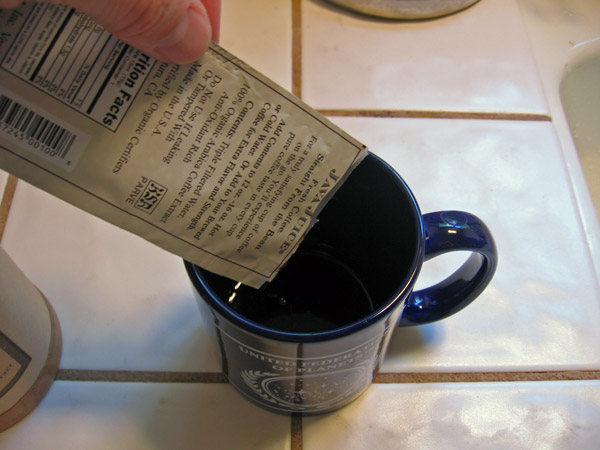
I open the package and poured the black gold out. A strong, delightful coffee aroma filled the air. I'm not sure exactly how they make it, but this is some serious coffee extract.
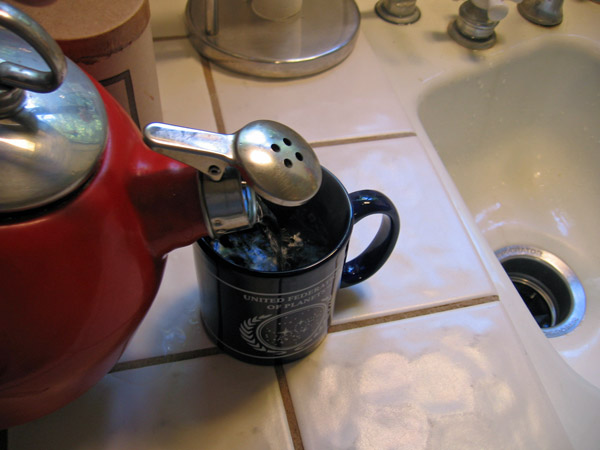
I add the hot water from the kettle. (Michele tried to clean the hot water dispenser with vinegar. It cleaned off the calcium deposits great, but the dispenser died. So we are back to heating water with a tea kettle until Michele decides on the new hot water dispenser.)
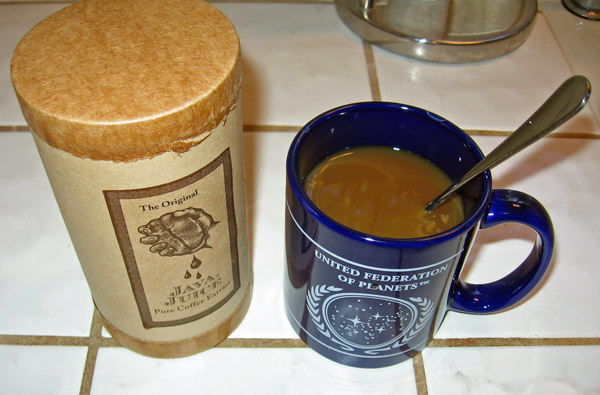
A little sugar and a little milk and we are ready. The taste? Pretty damn good. Much better than any regular instant coffee I've tried in the past. It's strong and has a more 'thick' feel to it that some of the thin coffees you encounter.
Michele gave it a try and she liked it as well. It's been offically added to the house staples.
Java Juice is great, but it ain't cheap. A single serving is 75¢ to $1, depending on the quantity you buy. Like most things in life, you get what you pay for. I brought a packet to work today, added the hot water from the work kitchen and I had a great cup of coffee. Compared to my usual choice of crappy free machine coffee and expensive yucky Starbucks coffee, it's well worth the price.
Zoe has been learning to play the Bass Guitar since January. I've been talking to my friend Paul about it and even discussed learning to play the guitar myself. Being a slacker, I've taken no action to actually move toward learning to play myself. Paul plays guitar and has mentioned it to me several times.
I was quite suprised this weekend when Paul presented me with my own starter guitar and amp.
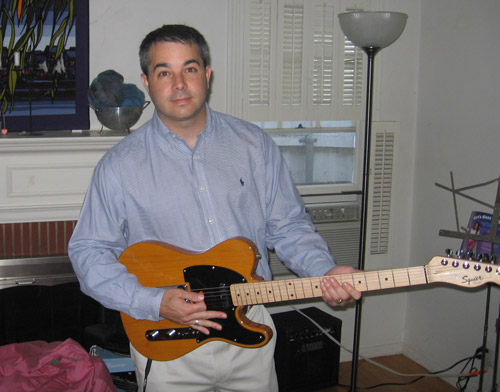
This is an exceedingly generous gift and I'm quite excited to start playing.
I've been goofing around with it, but need to start learning. I searched on 'learn to play guitar' on Google and was overwhlemed with sites. I have idea how to seperate the wheat from the chaff.
Any suggestions where to start would be appreciated!